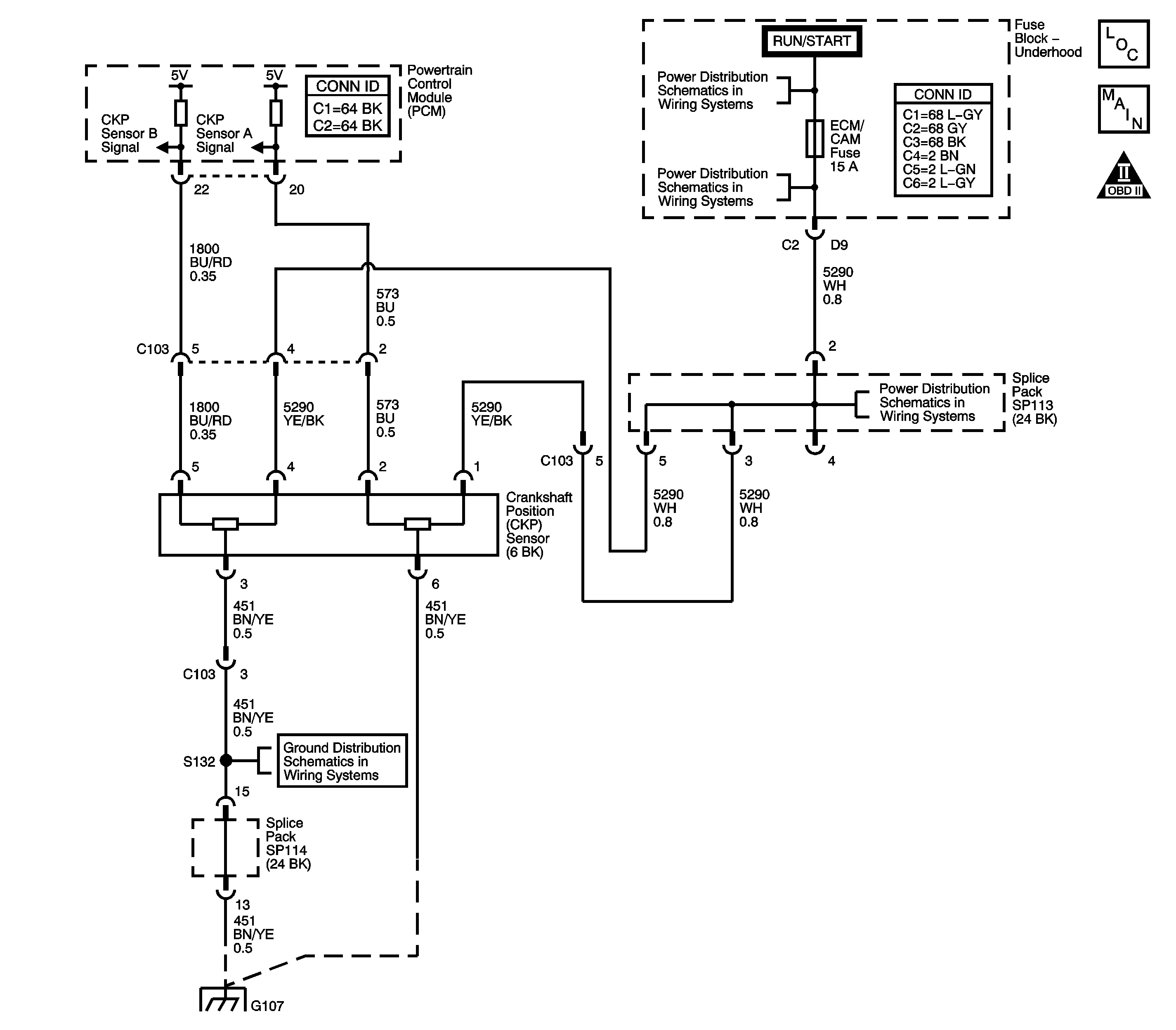
Circuit Description
The DTC P0336 Crankshaft Position (CKP) Sensor A Performance diagnostic monitors the stability of the signal from the CKP sensor A. The CKP sensor is a magnetic generator type sensor, producing an alternating current signal. The CKP sensor signal increases in both frequency and amplitude as the engine RPM increases. The CKP sensor sends this reference signal to the powertrain control module (PCM) to indicate the crankshaft RPM and position. This reference signal is used by the PCM to calculate fuel injection pulse, establish top dead center (TDC) for ignition timing and where to start ignition coil and injection sequencing. There will be no spark or fuel delivery if there is no CKP sensor signal.
DTC Descriptors
This diagnostic procedure supports the following DTC.
DTC P0336 Crankshaft Position (CKP) Sensor A Performance
Conditions for Running the DTC
| • | DTC P0340, P0341, or P0385 are not set. |
| • | The engine is running. |
| • | DTC P0336 runs continuously once the above conditions are met. |
Conditions for Setting the DTC
The PCM detects less than or more than 22 pulses per crankshaft revolution.
Action Taken When the DTC Sets
| • | The control module illuminates the malfunction indicator lamp (MIL) on the second consecutive ignition cycle that the diagnostic runs and fails. |
| • | The control module records the operating conditions at the time the diagnostic fails. The first time the diagnostic fails, the control module stores this information in the Failure Records. If the diagnostic reports a failure on the second consecutive ignition cycle, the control module records the operating conditions at the time of the failure. The control module writes the operating conditions to the Freeze Frame and updates the Failure Records. |
Conditions for Clearing the MIL/DTC
| • | The control module turns OFF the malfunction indicator lamp (MIL) after 3 consecutive ignition cycles that the diagnostic runs and does not fail. |
| • | A current DTC, Last Test Failed, clears when the diagnostic runs and passes. |
| • | A history DTC clears after 40 consecutive warm-up cycles, if no failures are reported by this or any other emission related diagnostic. |
| • | Clear the MIL and the DTC with a scan tool. |
Diagnostic Aids
Excess crankshaft end play causes the reluctor wheel to move out of alignment with the CKP sensor. This could result in an intermittent DTC P0336.
An intermittent malfunction may be caused by a fault in the CKP sensor circuit. Inspect the wiring harness and the components for an intermittent condition. Refer to Intermittent Conditions .
If the DTC P0336 cannot be duplicated, the information included in the Freeze Frame data can be useful in determining the vehicle operating conditions when the DTC was first set.
Test Description
The numbers below refer to the step numbers on the diagnostic table.
-
The Diagnostic System Check-Engine Controls prompts the technician to complete some basic checks and store the Freeze Frame data on the scan tool if applicable. This creates an electronic copy of the data taken when the fault occurred. The information is then stored in the scan tool for later reference.
-
This step determines whether the DTC P0336 is the result of a hard failure or an intermittent condition.
-
This step tests the CKP sensor input circuit.
-
After replacing the PCM a new minimum throttle position and idle speed must also be established.
Step | Action | Values | Yes | No | ||||
|---|---|---|---|---|---|---|---|---|
Connector End View Reference: Powertrain Control Module Connector End Views or Engine Controls Connector End Views | ||||||||
Did you perform the Diagnostic System Check-Engine Controls? | -- | Go to Step 2 | ||||||
2 |
Does the scan tool display a rolling count within the specified range? | 0-3 Counts | Go to Step 3 | Go to Step 4 | ||||
3 |
Is DTC P0335 set? | -- | Go to Step 4 | Go to Diagnostic Aids | ||||
4 |
Did the test lamp illuminate? | -- | Go to Step 5 | Go to Step 8 | ||||
5 |
Is the voltage near the specified value? | 12 V | Go to Step 6 | Go to Step 9 | ||||
Is the voltage near the specified value? | 5.0 V | Go to Step 11 | Go to Step 7 | |||||
7 |
Did you find and repair a condition? | -- | Go to Step 15 | Go to Step 10 | ||||
8 |
Did you complete the repair? | -- | Go to Step 15 | -- | ||||
9 |
Did you complete the repair? | -- | Go to Step 15 | -- | ||||
10 |
Did you find and correct a condition? | -- | Go to Step 15 | Go to Step 14 | ||||
11 |
Did you find and correct a condition? | -- | Go to Step 15 | Go to Step 12 | ||||
12 |
Did you find and correct a condition? | -- | Go to Step 15 | Go to Step 13 | ||||
13 | Replace the crankshaft position sensor. Refer to Crankshaft Position Sensor Replacement . Did you complete the replacement? | -- | Go to Step 15 | -- | ||||
Did you complete the replacement? | -- | Go to Step 15 | -- | |||||
15 |
Does the DTC run and pass? | -- | Go to Step 16 | Go to Step 2 | ||||
16 | With a scan tool, observe the stored information, Capture Info. Does the scan tool display any DTCs that you have not diagnosed? | -- | System OK | |||||
